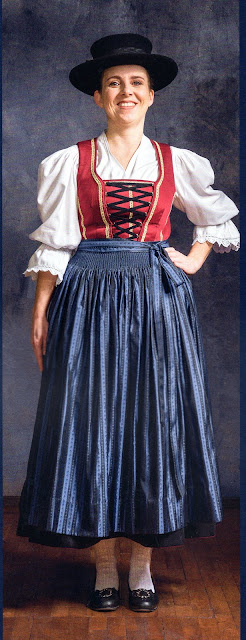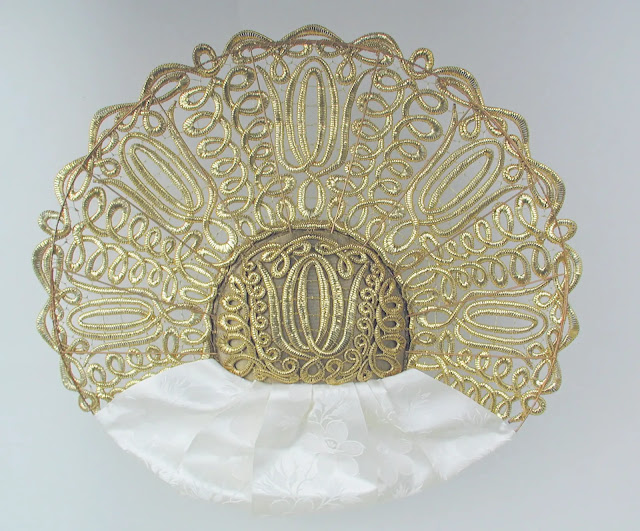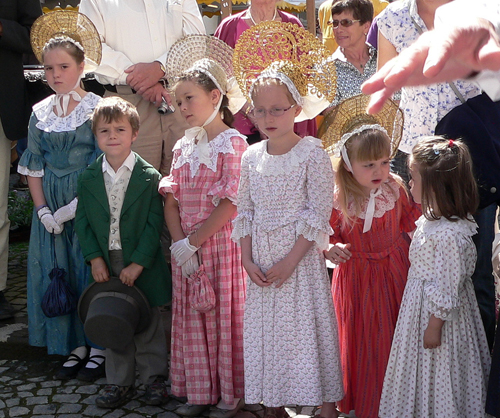Hello all,
Today I will conclude my overview of the trachten of Vorarlberg by talking about the western lowlands along the Rhine and the Bodensee. These trachten vary not only by location, but also social class. These costumes are more of the urban tradition rather than the folk. Ordinary people wore the black chenille radhaube, which we saw in my last article, but the upper class wore the radhaube made in gold, as we can see in the image at the head of the article. The people in the photograph are likely from Feldkirch.
Leiblachtal
region 1
This lowlying valley lies in the north of Vorarlberg, bordering the Bodensee [Lake Constance]. The Leiblach river forms the border with Germany, so that the area east of the river is Austrian, and the part west of the river is German. Both the flat Vorarlberg hat and the black chenille radhaube are worn in this valley.
Rheintal
region 11
The upper Rhine River more or less forms the border between Austria and Switzerland between the Bodensee and Liechtenstein. This is the most densely populated region in Vorarlberg. I will present the volkstrachten from north to south.
There is a tracht for the Rheintal in general.
Notice that while the last two are labelled Bregenz, they in fact show the same tracht as those above.
Bregenz
This is the major urban center in Vorarlberg. It does not form part of the region of Bregenzerwald. It has a very old history, the name being derived from either a Celtic language, or Ligurian, [Brigant-], meaning outstanding. The area has been Allemanic speaking for many centuries. The volkstracht has a round neckline, with a row of ruched ribbon around the front, and extending into a V on the back.
Lustenau
This town is right up against the Swiss border. It was first mentioned in historical records in the year 887. They do have a currently active trachtengruppe.
Hohenems
This town has an Urban upper class tracht, but also a folkstracht, for which I have only been able to find one image.
Rankweil.
This town has both a traditional Urban tracht and a couple of different volkstrachten.
This town is the second largest in Vorarlberg, and is the westernmost point in Austria, being found right on the border of both Liechtenstein and Switzerland.
This town has a very strong traditional Urban tracht, but also has a volkstracht. Both seem to be alive and well in this town.
Patriziertracht
This is the last type of traditional attire of this region. This was the traditional clothing of the Urban upper class. Each of the large urban centers had its own version of this outfit, but they had much in common. Generally, it consisted of a full length silken gown, with the gold radhaube. The men would wear frock coat, jabot, and either top hat or tricorn.
The gold radhaube came in two types. One version consisted of prefabricated gold lace stretched over the wheel frame. This is quickly made and is less expensive. This is found in those cities where the black chenille radhaube is more usual. Here is an example from Dornbirn.
The true gold radhaube had the lace woven directly onto the wheel frame. This takes longer and is more costly, but the result is superior. This type is typical of the cities of Bregenz and Feldkirch.
Each major urban center had its own version. Note that each gold radhaube is handmade, and has a different design.
Bregenz
Dornbirn
This is the largest city in Vorarlberg. The town costume here traditionally used the black chenille radhaube, but occasionally one will see a gold radhaube made in the same way.
https://en.wikipedia.org/wiki/DornbirnHohenems
The traditional urban attire in this town also uses the black chenille radhaube, although it includes gold embroidery on the back.
In this image, the bareheaded woman is wearing a version of the tracht of Montafon. The rest are in Hohenems tracht.
The urban clothing of this town also includes the black radhaube.
Bludenz
This city is found at the head of the Walgau, but has a traditional urban tracht as well. The gold radhaube here has the same construction as the black radhaube.
This city, along with Bregenz, is the home of the true gold radhaube in Vorarlberg.
And that concludes my overview of the traditional costumes of Vorarlberg.
I hope that you have found this to be interesting and informative. It is amazing how much can sometimes be found in a small area.
Roman K.
email: rkozakand@aol.com
Source Material:
'Die Trachten in Vorarlberg', Ulrike Bitschnau et al, Bregenz 2022
'Alpentrachten Unserer Zeit', Karl Wolf et al, Wien, 1937
'Trachten in Österreich', Rudolf Fochler, Wels, 1980
'Die Goldene Bodensee-Radhaube', Michael Selb, Wien, 2011
'Österreichische Trachtendirndl', Maria Strnad, Wien, 1950
'Tracht in Österreich', Franz C. Lipp et al, Wien, 1984
'Ostmark Fibel', Kuno Brandauer, Munich, 1941







































































































































































Thank you for this wonderful dive into one small area of the world! The gold head gear is so splendid but I did notice some very nice thread worked buttons on a gentleman's coat and will have to go back and take a long look or two. Hope you had as much enjoyment putting these posts together as I've had looking at them. Charlotte in California
ReplyDeleteEmbroidery, an age-old craft cherished for its elegance and intricacy, has long been revered as a form of artistic expression. Custom embroidered patch
ReplyDeleteI am from Vorarlberg and seeing how you beautifully researched our folklore warmes my heart! Thank you
ReplyDeleteI loved this series on Austria, and can't wait to see other regions covered! (maybe Styria?)
ReplyDeleteI must say it is very informative blog as well as interesting. Many thanks
ReplyDeleteSuch a clever blog work, Keep doing this kind of post, I support you
ReplyDeleteI’ve been following this web site. Thank you for providing a fine content!!!
ReplyDeleteContinue for sharing such a excellent post here. Keep on sharing, Thanks
ReplyDeleteThis is a tremendous post Keep up the great work. Sharing is nice keep it up
ReplyDeleteThank you so much for caring about this content and to your reader.
ReplyDeleteI wanna say thank you for providing this great information. Great job
ReplyDeleteI personally believe that the word “diversity” has multiple definitions
ReplyDeleteervice which means an equal connection of different colors.
ReplyDeleteso happy to find good place to many here in the post, the writing is just great, thanks for the post.
ReplyDelete